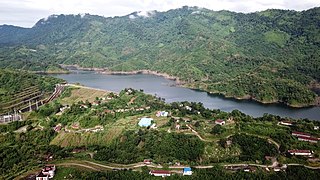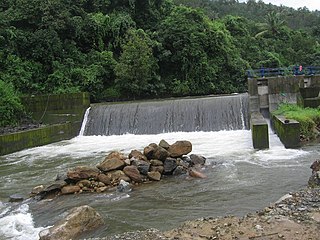Related Research Articles

Small hydro is the development of hydroelectric power on a scale suitable for local community and industry, or to contribute to distributed generation in a regional electricity grid. Exact definitions vary, but a "small hydro" project is less than 50 megawatts (MW), and can be further subdivide by scale into "mini" (<1MW), "micro" (<100 kW), "pico" (<10 kW). In contrast many hydroelectric projects are of enormous size, such as the generating plant at the Three Gorges Dam at 22,500 megawatts or the vast multiple projects of the Tennessee Valley Authority.

The Idukki Dam is a double curvature arch dam constructed across the Periyar River in a narrow gorge between two granite hills locally known as Kuravan and Kurathi in Idukki, Kerala, India. At 168.91 metres (554.2 ft), it is one of the highest arch dams in Asia. It is constructed and owned by the Kerala State Electricity Board. It supports a 780 MW hydroelectric power station in Moolamattom, which started generating power on 4 October 1975. The dam type is a concrete, double curvature parabolic, thin arc dam. The Indo-Canadian project was inaugurated by the Prime Minister Indira Gandhi on February 17, 1976.

Kerala State Electricity Board (KSEB) is an Indian public sector undertaking under the Government of Kerala that generates, transmits and distributes electricity in the state under government monopoly. Established in 1957, the agency comes under the authority of the Department of Power. It has been registered under Indian Companies Act 1956 during January 2011.
Kavilumpara is an agricultural village in northeastern Kozhikode district in Kerala. It shares a border with Wayanad District.

Himachal Pradesh is extremely rich in its hydroelectricity resources. The state has about twenty five percent of the national potential. About 27,436 MW of hydroelectric power can be generated in the state by the construction of various hydroelectric projects on the five perennial river basins. Out of total hydroelectric potential of the state, 10,519 MW is harnessed so far, out of which only 7.6% is under the control of Himachal Pradesh Government while the rest is exploited by the Central Government. The state government has been giving the highest priority for its development, since hydroelectric generation can meet the growing need of power for industry, agriculture and rural electrification. It is also the biggest source of income to the state as it provides electricity to other states.

Kerala, a state in Southern India, has a network of 11 National Highways, 72 State Highways and many district roads.

Vilangad is a village in Kozhikode district in the state of Kerala, India. Vilangad is a small town, north-east of Kozhikode district bordering with Wayanad and Kannur. It is situated 32 km. away from sub-district headquarter Vatakara and 71 km. away from district headquarter Kozhikode.

Aripara Falls [alternate spelling: Arippara Falls (അരിപ്പാറ)] is a tourist spot in Anakkampoyil near Thiruvambady Town in Kozhikode district, Kerala. It is located on the Thiruvambady - Anakkampoyil route, 15 km from Thiruvambadi. The waterfall is a tributary of Iruvanjippuzha. There is a proposal for implementing a hydro power project on the Arippara waterfall.
Kuttiady is one of the Major towns situated in the north-eastern part of Kozhikode district of Kerala, India. It is located 24 km (15 mi) from Vadakara and 50 km (31 mi) from Kozhikode. Kuttiady is situated in the slopes of the Western Ghats.

Kozhikode Light Metro is a proposed Light Metro system for the city of Kozhikode (Calicut), in India. In 2010, the State government explored the possibility of implementing a metro rail project for Kozhikode city and its suburbs. The proposal was to have a corridor connecting Meenchanda to the Kozhikode Medical College Hospital through the heart of the city. An inception report was submitted by a Bangalore-based consultant, Wilber Smith, on the detailed feasibility study on the prospect of implementing the Mass Rapid Transport System (MRTS) and Light Rail Transit System (LRTS) in the city. However, the project has been scrapped to be replaced by Kozhikode Monorail project.

Tuirial dam is an earthfill and gravity dam on the River Sonai near Kolasib in the state of Mizoram in India. The primary purpose of the dam is hydroelectric power production. The Cabinet Committee on Economic Affairs (CCEA) approved the 60 MW Tuirial Hydro Electric Project (THEP) project costing Rs 913 crore in 2010. The project was inaugurated by Prime Minister Narendra Modi on 16 December 2017.

Emerging Kerala is the name given to a biennial investors summit held by the Government of Kerala in Kerala, India. The event is aimed at bringing together business leaders, investors, corporations, thought leaders, policy and opinion makers.

Ayathil is a neighbourhood in Vadakkevila zone of Kollam city, Kerala, India. It is the 36th ward in Kollam Municipal Corporation. It is one of the cashew processing hubs in Kollam city. Kerala State Cashew Development Corporation Limited has a factory there. Kollam Bypass passes through Ayathil.
The Chaskaman Dam is one of the important dams of Maharashtra and is built on the Bhima River at Rajgurunagar in Pune district. It is located across river Bhima in Krishna basin near Village Bibi in Khed taluka. The main purpose of this dam was to improve irrigation and supply of electricity to the nearby villages. It is the second Hydel Greenfield power project in the country that is capable of captive power as well. The power will be utilized through the state power board. The project was completed during 2008-09.

Urumi 1 Weir is small diversion dam constructed across Poyilingalpuzha in Koodaranji village of Kozhikode district in Kerala, India. This weir is constructed for power generation in a Small Hydro Electric Project and is constructed across the Poylingalpuzha which is tributary of Chaliyar river. Location is at Urumi near Poovaranthodu, Koodaranji village of Kozhikode district. Height from deepest foundation is 5.6 metres (18 ft) and the length is 47.0 metres (154.2 ft).

Urumi 2 Weir' is a small diversion dam constructed across Poyilingalpuzha in Thiruvambady village of Kozhikode district in Kerala, India. The weir is constructed across the Poyilingalpuzha river, downstream of Urumi I power house to divert water to Urumi II power house. This is located in Thiruvambady, 50 km away from Kozhikode town. The water from the reservoir is drawn to the Power House through a power channel 470 m long. The Urumi falls near the dam has become a tourist attraction after the hydro electric project came into existence.

Chembukkadavu Weir is a small diversion dam constructed across Chalipuzha in Kodenchery village of Kozhikode district in Kerala, India. The location of the scheme is at Chembukadavu near Tusharagiri in Kodencherry village of Kozhikode district. It is 55 km away from Kozhikode town. The weir is constructed across Chalipuzha river. After power generation, water from the power station is utilised for Chembukadavu II. The Power generated in the station is at 6.3 kV. This is stepped up to 33 kV and transmitted to 110 kV substation, Agasthyamoozhy. The weir and the power house is operated and maintained by Kerala State Electricity Board.

Panoth Weir is a small diversion dam across Vaniyam puzha which is a tributary of Mahe puzha at Panoth in Naripatta panchayath in Vilangad village of Kozhikode district in Kerala, India. It is the second weir of Vilangad SHEP. It is located at Panoth near Vilangad in Vadakara taluk of Kozhikode district. The project was commissioned in 2014 The weir has a height of 8.55 metres (28.1 ft) from deepest foundation and a length of 44.5 metres (146 ft)
Valook Weir is a small diversion dam constructed across Kavadippuzha in Naripatta panchayath of Kozhikode district in Kerala, India. It is one of the two weirs of Vilangad SHEP. It is located 85 km away from Kozhikode town. It is a run- off the river scheme utilizing water of Vaniyampuzha and Kavadipuzha. The weir has a height of 7.9 metres (26 ft) from deepest foundation and a length of 45.95 metres (150.8 ft).
The Allunkal Dam is a concrete diversion weir built across the Kakkad River in Chittar panchayat of Ranni taluk in Pathanamthitta district of the Indian state of Kerala. The dam is 121 metres (397 ft) long and 12 metres (39 ft) tall above the bed. It is part of the Ullunkal Hydroelectric Project, a small-scale private hydroelectric project operated by EDCL Power Projects Limited, a subsidiary of Energy Development Company Limited (EDCL).
References
- ↑ Kerala (19 June 2015). Hydel Project. Financial Express.
- ↑ Road to Thusharagiry & Chembukadavu.